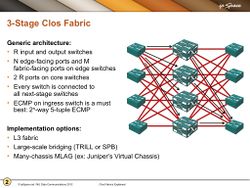Leaf-and-Spine Fabric Architectures
Overall rating: 4.69 Instructor: 4.76 Materials: 4.68 more …
Every major networking vendor is busy promoting its own (usually proprietary) Data Center Fabric. While they're debating the architectures and proprietary nature of competitors' offerings, and solving dubious problems like large-scale bridging with pre-standard implementations, the data center users still face the problem succinctly expressed by James Hamilton: "Data Center Networks are in my Way".
It turns out we don't need rocket-science data center fabric solutions to solve that problem - it's possible to build large all-point-equidistant networks with no constraints on workload placement with existing gear from numerous vendors using decades-old Clos architectures.
The Leaf-and-Spine Fabric Architectures webinar describes the Clos architecture concepts used to build leaf-and-spine architectures, and single- and multistage designs that can be used to build large layer-2 or layer-3 all-point-equidistant Data Center networks.
Contents
The webinar covers these topics:
Introduction to Leaf-and-Spine Architectures
- The challenges of traditional 3-tier data center architectures
- Flatting the data center network
- Leaf-Spine (or Clos) architectures
- Multi-stage leaf-and-spine fabrics
- Leaf-and-spine design process
- Deployment considerations
Layer-3 Designs
- Non-redundant and redundant layer-3-only designs
- Routing protocol selection
- Core (leaf-to-spine) link addressing and unnumbered interfaces
- BGP and OSPF design and implementation details
In the second part of this section, Dinesh Dutt described BGP over unnumbered interfaces and other features added to Cumulus Linux to simplify leaf-and-spine fabric deployments.
Routing Protocol Design
There are many assumptions and myths around the choice of a routing protocol that can be used in constructing routing paths in a richly meshed topology such as a leaf-and-spine (Clos) topology. Many think BGP is the only logical choice, others believe a link state protocol is the best choice. We explored BGP in the previous section, this section focuses on using OSPF in Clos topologies.
Few people have been willing to explore Clos topologies beyond the classical 2-tier leaf-spine topology. In the second part of this section, we'll explore the nuances of routing protocol choices and designs in 3-tier Clos topologies.
Pure Layer-3 Fabrics
- Host routing (propagating host routes across layer-3 fabric)
- Hosts (servers) participating in fabric routing protocol (multihoming, containers…)
In the guest speaker presentation, Dinesh Dutt described the Redistribute ARP feature of Cumulus Linux and some large-scale virtualization scenarios in which hosts participate in the fabric routing.
Layer-2 Designs
- Simple layer-2-only designs using either MLAG or layer-2 fabric technologies
- Layer-2 designs with redundant server connectivity
- Implementation of layer-2 fabrics with overlay virtual networking
In the second part of this section, Roger Lapuh (Avaya) described the technical details of Shortest Path Bridging (SPB), its implementation in Avaya Fabric, and explain how SPB increases network resiliency and simplifies Data Center consolidations and migrations.
Mixed Layer-2 + Layer-3 Designs
This section builds on the principles introduced in layer-2 designs and layer-3 designs and describes these typical scenarios:
- Routing on a single spine switch
- Routing on multiple spine switches (multiple active default gateways)
- Anycast spine routing implementation in SPB or TRILL
- Anycast leaf gateways
- Anycast leaf gateways using overlay transport across fabric core
- Layer-3-only fabrics implemented with routed core or overlay transport.
In the guest presentation Lukas Krattiger (Cisco Systems) describes the EVPN control plane, its use with VXLAN overlays, and Cisco’s implementation of EVPN with VXLAN.
Multi-Pod and Multi-Site Fabrics
As Data Center network designs are evolving and moving to overlays, the traditional hierarchies are fading. In this part of the webinar we will discuss how the Multi-Pod and Multi-Site concepts address this shift and which is best suited for what purpose; is it the blunt stretch of a broadcast domain or the hierarchical separation of network domains.
We will take a deeper look at the concepts, touch on the insides and the mechanics of the Multi-Pod and Multi-Site fabrics, and explore the implications to the underlaying transport network.
Happy Campers
About the webinar
- Good info on Leaf and Spine design overview and consideration
- Quinton Clark
- This webinar is the best datacenter underlay reference out there. It clarifies many concepts and clears misconceptions. Now only it helped me to understand simple leaf-and-spine topologies, but also more complex CLOS multi-stage designs. This webinar is my primary source of inspiration when I write about modern datacenter underlays. I thoroughly recommend it. Antonio Sanchez-Monge. @virtualhops.
- Antonio Sanchez Monge
- I like the level of depth and practical information in your webinars. Thanks!
- David
- Hello, the session was about layer 2 fabrics. I work at a higher level of the stack, so it was a real eye opener specially with so much opinionated "myths?" on the web that haven't been critically challenged such as STP. Really interesting.
- Tony de Sousa
- good format
- Boris Khasanov
- There was some good information on EVPN and VXLAN topologies, especially at a theoretical level, but unfortunately it has lacked a lot of concrete examples and explanations. Compared to the sessions with other speakers, it lacked a lot of additional information to make me properly grasp some of the concepts. As an example, the symmetric IRB was explained for L3 traffic but not for L2 traffic, there were no configuration examples with full traffic flow explanations. I kept waiting for the moment where it would actually get into such a concrete example, like we are usually accustomed to.
All of the other sessions so far have been great and it is unfortunate that this one is the first one that really left me hanging, which in a way also praises all the past ones.
Unfortunate for this one, but does not bring down the overall value of all sessions. - Steve Johnson
- Very nice, a good place to ask questions.
- Martin Bernier
- It was wonderful session. I like the way Ivan actually spending time in clearing the doubts during the webinar. He never said let me move on as we have less time on hands. I am looking forward to attend more
- Mohit Garg
- I enjoyed the simple, concise explanations of the technology and various options. It's made even better by being able to ask questions.
- Bruno Wollmann
- Just fantastic
- Bhargav Bhikkaji
- Most of the deployment scenarios are covered in this webinar.This gives an excellent overall picture of leaf-and-spine architectures.I would recommend this webinar even for Engineers working on Data center technologies.I couldn't find any other resource on internet going such a depth in this area.
- Krishna Prasad S
- Excellent
- Jan Colpaert
- Technical, and well explained.
Great as it covers all the different fabric L+S usecases. - Rick Donato
- Mandatory viewing to stay abreast of current and future developments in the data center
- Leendert van den Dool
- This is a standout from the crowd.This focusses on the very basics than on how you configure stuff.Really worth all your time and money.
- Sanoop R
- A profitable time to spend
- Francois DEFROCOURT
- This was good, for me some topic are very deep dives, because I'm in the quite beginning of my career in this topic. But, the content has been good and still relevant, excluding some technologies that have been replaced since the oldest videos - but the concepts usually remain. Thanks for the good video content!
- Feeliks Kilpi
About the instructor
- Its good to have someone who is methodical leading the sessions and I appreciate not having to listen to bluster and grandiose conjectures. I like hearing the facts and counter-facts.
- Tony de Sousa
- He is just great
- Mohit Garg
About the materials
- More in-depth technical design for CLOS technology components i.e. OSPF ECMP and redundant, multi-vlan L3 access (Leaf) design would be great as most datacentre deployments require this.
- Quinton Clark
- It is great to have this kind of independent top quality content available to browse and watch. This is the place to be and I will renew year after year. Antonio Sanchez-Monge. @virtualhops.
- Antonio Sanchez Monge
- it would be great if you explain different between TRILL, FabricPath, QFabric, etc in detail.
- Radityo Honggoyudho
- I thought that starting out with pure
layer-3 fabrics was a great pedagogical
choice - Buck Huppmann
- Hi Ivan
I really enjoy your webinars and can't wait for the next one. :-)
What I would like to see in your webinars is a greater focus on the "real world" datacenters out there. I know, there are big and fancy datacenters out there, all running cumulus Linux switches and Linux servers and so on. However, I think (even though I would love it to be otherwise), the majority of companies still run bloody Windows servers. So do we. I therefore would love to see more focus on solutions that work with Windows servers. Unfortunately many of your myth busts just work if you're running Linux server. We're not. Damn it. :-)
Anyway. See (hear) you tomorrow for the next session.
Regards from sunny and warm, easterly Switzerland
Patrick - Patrick Sigrist
- I would like to say if we can add FAQs in written form with every webinar It would be easy for everyone to read through and clarify their thoughts
- Mohit Garg
- Spot on.
- Rick Donato
- Everything is nice.However, i would like to see EVPN+VXLAN configuration and packet path covered like we covered the BGP underlay.
- Sanoop R
- For some reason I still could not access all the materials, due to missing expert subscription that is not available anymore.
- Feeliks Kilpi
The Authors
Guest stars
Target Audience
This webinar is ideal for architects and designers that have to look behind the vendor marketectures and build large-scale solutions that meet their business and operational requirements.
If you are a network architect, designer or sales/support engineer working in data center environment, you simply have to attend this webinar.


 Ivan Pepelnjak, CCIE#1354 Emeritus, is an independent network architect, book author, blogger and regular speaker at industry events like Interop, RIPE and regional NOG meetings. He has been designing and implementing large-scale service provider and enterprise networks since 1990, and is currently using his expertise to help multinational enterprises and large cloud- and service providers design next-generation data center and cloud infrastructure using Software-Defined Networking (SDN) and Network Function Virtualization (NFV) approaches and technologies.
Ivan Pepelnjak, CCIE#1354 Emeritus, is an independent network architect, book author, blogger and regular speaker at industry events like Interop, RIPE and regional NOG meetings. He has been designing and implementing large-scale service provider and enterprise networks since 1990, and is currently using his expertise to help multinational enterprises and large cloud- and service providers design next-generation data center and cloud infrastructure using Software-Defined Networking (SDN) and Network Function Virtualization (NFV) approaches and technologies.
 Dinesh Dutt has been in the networking industry for the past 20 years, most of it at Cisco Systems. Most recently, he was the Chief Scientist at Cumulus Networks, working on simplifying configuration and operations with inventions such as BGP Unnumbered and NetQ. Before Cumulus, he was a Fellow at Cisco Systems. He has been involved in enterprise and data center networking technologies, including the design of many of the ASICs that powered Cisco's mega-switches such as Cat6K and the Nexus family of switches. He also has experience in storage networking from his days at Andiamo Systems and in the design of FCoE. He is a co-author of TRILL and VxLAN and has filed for over 40 patents.
Dinesh Dutt has been in the networking industry for the past 20 years, most of it at Cisco Systems. Most recently, he was the Chief Scientist at Cumulus Networks, working on simplifying configuration and operations with inventions such as BGP Unnumbered and NetQ. Before Cumulus, he was a Fellow at Cisco Systems. He has been involved in enterprise and data center networking technologies, including the design of many of the ASICs that powered Cisco's mega-switches such as Cat6K and the Nexus family of switches. He also has experience in storage networking from his days at Andiamo Systems and in the design of FCoE. He is a co-author of TRILL and VxLAN and has filed for over 40 patents.

 Lukas Krattiger, CCIE No. 21921 (Routing and Switching/Data Center), is a Principal Technical Marketing Engineer (PTME) with more than 18 years of experience in Data Center-, Internet- and Application-Networks. Within the Cisco Enterprise Infrastructure and Solutions Group (EISG), he specializes in Data Center switching architectures and solutions across platforms. Lukas is a double-CCIE (R&S, Data Center) with several other industry certifications and has participated in various technology leadership and advisory groups.
Lukas Krattiger, CCIE No. 21921 (Routing and Switching/Data Center), is a Principal Technical Marketing Engineer (PTME) with more than 18 years of experience in Data Center-, Internet- and Application-Networks. Within the Cisco Enterprise Infrastructure and Solutions Group (EISG), he specializes in Data Center switching architectures and solutions across platforms. Lukas is a double-CCIE (R&S, Data Center) with several other industry certifications and has participated in various technology leadership and advisory groups.